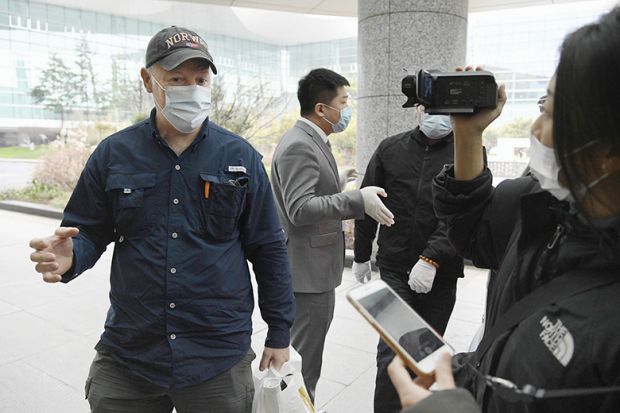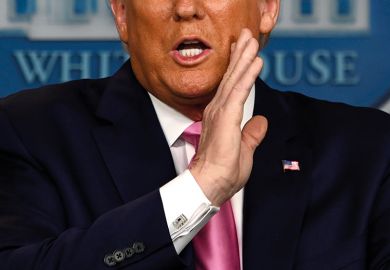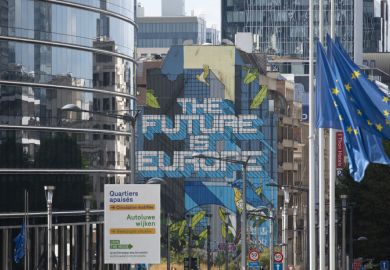Just a month ago, the idea that coronavirus came from an accidental lab leak in Wuhan was derided by much of the press as a fringe conspiracy theory and banned on Facebook as a form of misinformation.
Now, a host of distinguished scientists, including Anthony Fauci, the US White House’s chief medical adviser, credit the idea as plausible, if far from proven, and are calling for more openness from the lab at the centre of the theory, the Wuhan Institute of Virology (WIV).
This extraordinary about-turn has critics asking hard questions, including of elite academic journals, about whether it was right to have shunted the lab leak theory into the fringes in the first place.
Journalists who have rehabilitated the lab leak theory in recent months point the finger at The Lancet for allowing Peter Daszak, president of research funder the EcoHealth Alliance, to squash notions of a lab leak early on – without disclosing that he had a significant potential conflict of interest.
In February 2020, just as the Western world was waking up to the pandemic’s spread, Dr Daszak, a British zoologist who has become a controversial central figure in the origins debate, organised and signed a letter – along with a who’s who of pandemic experts – in The Lancet to “strongly condemn conspiracy theories suggesting that COVID-19 does not have a natural origin”. The letter has been mentioned in news stories more than 350 times so far.
While a “natural origin” might technically include a virus that was captured in the wild and then leaked, un-engineered, from the lab – a kind of “lab leak lite” hypothesis – this prospect was not addressed in the letter. Recently released emails show that, in April 2020, Dr Daszak wrote to Dr Fauci to thank him for publicly dismissing the idea of a “lab release”.
Dr Daszak chairs The Lancet’s task force looking into the origins of the pandemic. He was also part of the international team of experts who probed Wuhan for the World Health Organisation – and concluded a lab outbreak was “extremely unlikely”, despite the WHO’s own director general saying the team had not been allowed access to all data at the WIV.
But nowhere did The Lancet disclose a critical fact: Dr Daszak had for years funded and worked with WIV researchers to collect bat coronaviruses from the wild – in order to get ahead of them before they spread to humans – and led National Institutes of Health-funded work on, among other things, “virus infection experiments across a range of cell cultures from different species and humanized mice” to assess how they might spread.
“If the SARS2 virus had indeed escaped from research he funded, Daszak would be potentially culpable. This acute conflict of interest was not declared to The Lancet’s readers,” said an investigation into the theory published by the Bulletin of the Atomic Scientists in early May.
A spokeswoman for The Lancet said that Dr Daszak “is one of the world’s leading experts on zoonotic diseases, including coronaviruses, with experience working in China” and that his task force would assess “all leading hypotheses” including “laboratory release”. Dr Daszak did not respond to a request for comment.
Rossana Segreto, a former researcher at the University of Innsbruck, said that in January The Lancet rejected a letter by her and colleagues calling for an “open scientific debate” about the origins of the virus. A spokeswoman for the journal said that it did not comment on papers not published.
Dr Segreto also pointed a critical finger at Nature Medicine, which in March 2020 added an “editors’ note” to a 2015 paper documenting the creation of a “chimeric virus” from a bat coronavirus in work done in collaboration with the WIV. The note stresses that there is “no evidence” coronavirus was engineered.
But this 2015 paper, critics argue, is exactly the kind of research that could lead to a risky new virus, and the paper itself has been tweeted tens of thousands of times.
“That message in Nature should now be corrected,” said Dr Segreto. But a spokeswoman for the journal said that it would not amend the note “at this time and will continue to follow the scientific developments related to this topic”.
However, some prestige journals have also rehabilitated the lab leak theory, not just thrown cold water over it.
A turning point in the theory’s credibility came on 14 May, when Science published a letter signed by 18 eminent coronavirus experts arguing that the leak was a “viable” theory.
This was not the result of a change of policy by the journal to start taking the leak theory seriously, said Holden Thorp, editor-in-chief of the Science family of journals. “This letter was signed by important figures in the Covid story, and we decided to publish it,” he said. “We didn’t get anything prior to this that made it through our process.”
Magdalena Skipper, editor-in-chief of Nature, said that the Science letter was a “very legitimate call” for further investigation, and that no discussions about the origin of the virus had been “taboo” at Nature.
But she said she was “puzzled as to why we’re having [the debate] again in the absence of new evidence”.
POSTSCRIPT:
Print headline: Elite journals scrutinised in Wuhan lab leak debate
Register to continue
Why register?
- Registration is free and only takes a moment
- Once registered, you can read 3 articles a month
- Sign up for our newsletter
Subscribe
Or subscribe for unlimited access to:
- Unlimited access to news, views, insights & reviews
- Digital editions
- Digital access to THE’s university and college rankings analysis
Already registered or a current subscriber? Login







